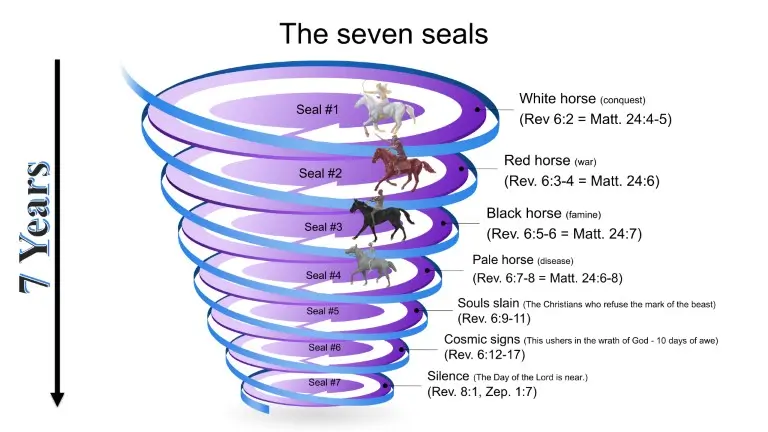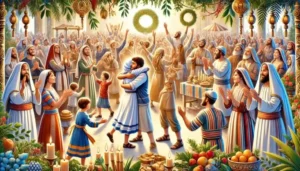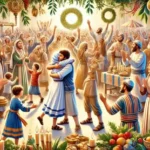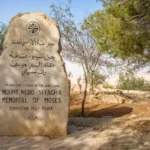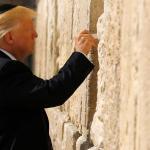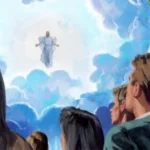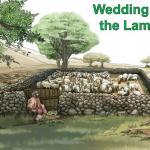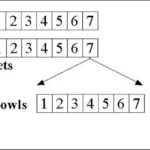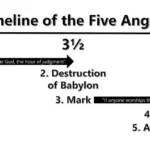Last Updated on December 6, 2024 by Steve
Three “sevens”
The book of Revelation is a real mystery at times and there are many theories as to how the three sequences of seven judgments fit into the seven years. Some take the seven seals happening first with the seventh seal opening the seven trumpet judgments and then the seventh trumpet judgment opening the last seven bowls of wrath or seven last plagues. At any rate, there does seem to be an increase in intensity as the sequences progress. In this article, part 1, I am only going to discuss the first of the seven seals. But suffice to say in my opinion the breaking of the seven seals and the trumpet judgments overlap somewhat (see my timeline) and it does appear that the seventh trumpet releases the last seven plagues.1 What makes it more difficult to understand though is that there are quite a few parenthetical chapters which interrupt the narrative flow. For example, the seventh trumpet judgment mentioned in Rev. 11:15 is interrupted by the parenthetical chapters 12–14 and then the seven last plagues begin in Rev. 15:1. I also see another interlude or parenthesis from Rev. 10:1–11:13 excluding the account of the angel and the little scroll and the account of the two witnesses from the second woe.2
Another important point is that whilst there does seem to be an overlap of the three lots of judgments with some of the judgments happening concurrently, within the sequences they do happen sequentially. In other words, it follows that seal 1 happens first, then seals 2,3,4,5,6, and 7. However, seal #7, trumpet judgment #7, and bowl #7 appear to roughly coincide all occurring within days of Christ returning in glory at the bottom end of the seven-year tribulation.
What is the double-sided scroll?
Rev. 5:1 tells us that the seven seals are on a two-sided scroll that the Father has in His hand whilst seated in the throne room in heaven. And it is only the Lamb, Jesus, who is the only one in the whole cosmos who is able and worthy to open the scroll and break the seven seals. The scroll was an opisthograph meaning that the entire message was written on both sides and it was sealed so that no one could read it unless it was unsealed. It seems to be modelled after Eze. 2:9–10 representing the fullness of the prophetic message given to Ezekiel.
In Rev. 5:3–4, John says that no one could open the scroll or even look inside it because it was sealed. The seven seals indicate the secrecy and inaccessibility of the contents of the scroll to all but those who are authorised to read it.
What is the content of the scroll?
The scroll contains the entire transcript of what will occur during the seven years and it is detailed from Rev. 6:1 to Rev. 22:6. It provides a preview of the disasters, judgments, woes and laments that are coming. John is told not to seal it up the prophecies contained in his book because the time is near.3 Daniel in contrast did not understand what he was being told and he was told to go your way because the words were sealed up unit the time of the end.
I don’t think that we have every last detail recorded in Revelation because what John sees is like a preview, a snapshot of what is coming with the purpose of warning Christians on the earth at the time to know what is happening and not to lose faith. For us now, it helps us to become ready and to sure up our faith so that at the time we don’t forget that God is in control—He hasn’t taken His hand off the wheel so to speak.
The purpose of opening the scroll is not so that it can be simply read but so that the eschatological events can begin to take place and the final consummation of victory take place. If no one could be found qualified enough to break open the seals then Satan would continue on and the Kingdom of God would not be established.
The white horse (1st seal)
This is perhaps the hardest seal to interpret and understand exactly its meaning. It is important because it marks the beginning of the final seven-year tribulation period. The other three coloured horses are much easier to understand because they represent a group that can easily be seen to be judgments upon the earth by God. The conjecture around the white horse seems to be around its colour. “White” in the Bible always seems to indicate divine purity and so the reasoning goes either that the white horse signifies either Christ or Elijah the prophet. In my opinion, the ‘Christ interpretation’ can be eliminated because Christ does not return to the earth at the beginning of the tribulation but at the end within the context of a post-tribulational rapture. Also, it can’t be Christ because it is the Lamb who opens the seals and the four living creatures who are saying, “Come!”4 It would not make sense for Christ to be breaking open the first of the seals only to allow Himself as the rider on the white horse to establish peace. Rather, He comes right at the end on a white horse in victory. A case is also made for it representing Elijah roaming the earth and conquering to kick things off for the first of the seven seals. However, a careful reading and study of Rev. 11:1 sees the two witnesses ministering at the Temple in Jerusalem. It says nothing about them travelling and conquering the world however they do release plagues upon the earth as time progresses through their 1260-day ministry and so they must be cognisant of what is happening all over the earth.5
Another salient point is that I feel that we must take the four horses and riders as a unit—the other three horses have a negative impact upon the earth and represent judgment with many people losing their lives through war, hyperinflation, and disease. We see at least one quarter of the earth’s population being killed. It seems odd that the white horse seal would be positive in the sense of peace whilst the other three horses have a negative connotation. More analysis of the other three horses in part 2.
On the other side, many scholars however see the white horse as the Antichrist who conquers the world using peace because there are no arrows in his bow and also it fits the pre-trib narrative of there being an initial peace agreement between Israel and the Antichrist according to an interpretation of Dan. 9:27. See my dealing with this issue in my blog “How do we know when the 7 year tribulation period starts” where I conclude that this confirming a covenant is, in fact, the reinstatement of the sacrificial system for a period for the Jews—the old covenant. This reaffirming is probably initiated by the two witnesses, particularly Elijah who is seen to have a restoration ministry. The other obvious problem with this theory is that the Antichrist does not rise from the abyss until the halfway mark as this is when it is actually opened.6 So it is not possible for him to arrive or rise from the dead before this point. His first point of business will be to kill the two witnesses7 and to put an end to sacrifice and offerings of the old covenant.8 From that point on the Bible says that there will be 1290 more days.9
The only other possibility is that the white horse represents a false peace tying in with the concept of deception which will be rife in the world at that time. Jesus’ first warning in response to the disciples’ enquiry into the signs of the end was, “Watch out that no one deceives you. For many will come in my name, claiming to be Christ.”10 As in the graphic above, there seems to be an obvious tie-in with the first four seals and the signs given in Matt. 24:4–8. Both the first four seals and the signs given at the beginning of birth pains in Matthew occur in the first half of the tribulation period.
So, my preferred interpretation is that the white horse is a worldwide leader who possibly claims to be a Messiah-type figure and brings a false deceptive peace to the earth through a type of bloodless conquest. This makes sense because the beast will have to hit the ground running when he arrives on the earth 3 ½ years later. The devil has been long at work to prepare the earth for his beast’s reign for the last short 1290 days. He knows his time will be short and he will be furious.11
For the next three seals see “The seven seals of Revelation – part 2“.

